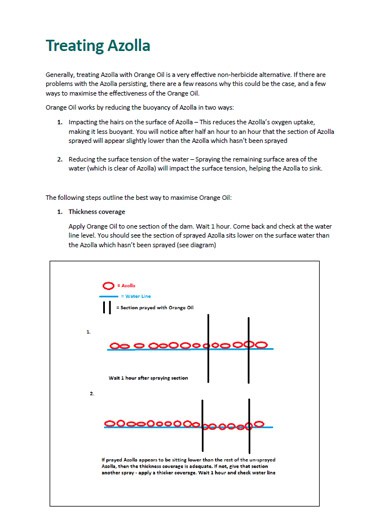
Treating Azolla With Orange Oil
PDF version:
Treating Azolla With Orange OilGenerally, treating Azolla with Orange Oil is a very effective non-herbicide alternative. If there are problems with the Azolla persisting, there are a few reasons why this could be the case, and a few ways to maximise the effectiveness of the Orange Oil.
Orange Oil works by reducing the buoyancy of Azolla in two ways:
- Impacting the hairs on the surface of Azolla – This reduces the Azolla’s oxygen uptake, making it less buoyant. You will notice after half an hour to an hour that the section of Azolla sprayed will appear slightly lower than the Azolla which hasn’t been sprayed.
- Reducing the surface tension of the water – Spraying the remaining surface area of the water (which is clear of Azolla) will impact the surface tension, helping the Azolla to sink.
The following steps outline the best way to maximise Orange Oil:

- Thickness coverage
Apply Orange Oil to one section of the dam. Wait 1 hour. Come back and check at the water line level. You should see the section of sprayed Azolla sits lower on the surface water than the Azolla which hasn’t been sprayed (see diagram). - Light spray on open water
Spray a light covering (mist) of Orange Oil over all water surface which is not covered in Azolla. Spraying open surface water will reduce the surface tension – helping the Azolla reduce buoyancy and sink. - Spraying in the air and let fall onto the target
Spraying too forcefully onto the Azolla can make the plant rock in the water and cause the Orange Oil to wash off. - Phosphorous (total P)
When phosphorous levels are high (over 0.025 mg/L), this leads to the Azolla becoming very robust and harder for a natural treatment to impact. High phosphorous means the Azolla has a constant and excess nutrient source. This allows it to bounce back very quickly after disturbance. In these instances, a registered herbicide is often required to effectively kill the Azolla. If a waterbody cannot have herbicide, then reducing the total P loading is one way to weaken the Azolla before treating with a natural remedy. Alternatively, harvesting the Azolla using machinery or manually scooping the Azolla out is another option for removal.

